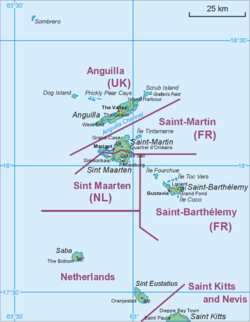Sabá
| Saba | |||
|---|---|---|---|
| Special municipality of the Netherlands | |||
|
|||
| Motto: "Remis Velisque" (Latin) "With oars and sails" (English) |
|||
| Anthem: "Saba you rise from the ocean" | |||

Location of Saba (circled in red)
in the Caribbean (light yellow) |
|||
 Map showing location of Saba relative to Sint Eustatius and Saint Martin. |
|||
| Coordinates: 17°38′N 63°15′W / 17.633°N 63.250°W | |||
| Country | Netherlands | ||
| Incorporated into the Netherlands | 10 October 2010 (dissolution of the Netherlands Antilles) | ||
| Capital (and largest city) |
The Bottom | ||
| Government (see Politics of the Netherlands) | |||
| • Lt. Governor | Jonathan Johnson | ||
| Area | |||
| • Total | 13 km2 (5 sq mi) | ||
| Population (2013) | |||
| • Total | 1,991 | ||
| • Density | 150/km2 (400/sq mi) | ||
| Languages | |||
| • Official | Dutch | ||
| • Recognised regional | English | ||
| Time zone | AST (UTC−4) | ||
| Calling code | +599-4 | ||
| ISO 3166 code | BQ-SA, NL-BQ2 | ||
| Currency |
U.S. dollar (USD) |
||
| Internet TLD | .an,.nl | ||
in the Caribbean (light yellow)
Saba (/ˈsɑːbə/; Dutch pronunciation: [ˈsaːbɑ]) is a Caribbean island and the smallest special municipality (officially public body) of the Netherlands. It consists largely of the potentially active volcano Mount Scenery, at 887 metres (2,910 ft) the highest point of the entire Netherlands.
Saba has a land area of 13 square kilometres (5.0 sq mi). As of January 2013[update], the population was 1,991 inhabitants, with a population density of 150 inhabitants per square kilometre (390/sq mi). Its towns and major settlements are The Bottom (the capital), Windwardside, Hell's Gate and St. Johns.
The origin of the name "Saba" comes from the Arabic word Sabha, meaning the Biblical kingdom of Sheba.
Like many Caribbean islands, Saba is highly dependent on fossil fuels imports, which leaves it vulnerable to global oil price fluctuations that directly impact the cost of electricity. Current electricity supply depends entirely on one diesel power plant located close to sea level by the harbour and it is estimated that fifty per cent of the cost of electricity is related to the price of fossil fuels and lubricants. According to a report by the Low Emission Development Strategies Global Partnership (LEDS GP), the Government of Saba made the decision to transform the island to 100% sustainable energy to eventually eliminate dependence on fossil fuel-generated electricity. This new energy policy is defined by the ‘Social development plan 2014–2020’ and ‘Saba's energy sector strategy’. Intermediate targets are 20% renewable electricity by 2017 and 40% by 2020.
...
Wikipedia


